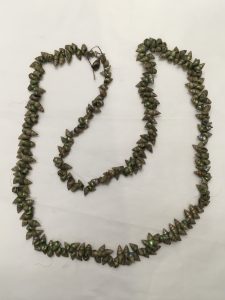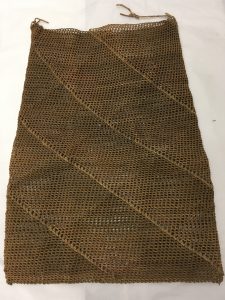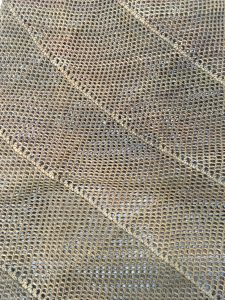Women’s work: Making discoveries in the Australian collection
Posted on by Fay Curtis.
By Polly Bence, University of Bristol, Department of Anthropology and Archaeology
My research focuses on cultural objects from Oceania – an understudied part of the collection at Bristol Museum & Art Gallery. Earlier in 2022 I undertook a four month placement and my aim was to focus on the documentation for these collections.
During a 1970s storage move the curatorial team created index cards with information for each object. Small black and white photographs were added to some cards.
I systematically worked through approximately 2,000 objects from across Oceania. It was a good way to ‘see’ the collection and I was able to add information to many existing records. The aim was to find objects that (although entered into the Registers) did not have a corresponding record on the database. In total I found 182 objects which would not come up in a database search. Most of these objects are from Papua New Guinea and New Zealand and include many important Maori cloaks. During the placement we managed to locate most and take photographs. We are now transferring these records to the database so that these objects become more accessible.
During the placement I consulted with curators in Archaeology, World Cultures and Natural History. I also reached out to institutions in London, Wales, Wiltshire, and contacted researchers in New Zealand and Australia. I have made some exciting discoveries whilst looking through the index cards and some of those will feature in my final thesis. I want to highlight two Australian objects, which although had a database record, the information was incorrect.
Firstly, this bag currently stored in the New Guinea collection has ‘no history’ (E1023). Looking at a photograph, I could see that this is a looped and knotted bag made in eastern Australia. The striking diagonal pattern indicates it is from the region from northeast New South Wales to southeast Queensland. Made by Aboriginal women in the mid-nineteenth century who soaked, dried and hardened fibres over ashes. These fibres were then knotted together diagonally. Some bags included coloured fibres of the plant which resulted in a graduating pattern (see Bolton 2011). In a certain light, this bag has a pinky tone.
Figures 1 and 2: Looped and knotted bag from northeast New South Wales or southeast Queensland. Acquisition details unknown. Bristol Museum & Art Gallery (E1023), © Bristol Culture
Secondly, this shell necklace on the database as ‘Solomon Islands?’ can now be identified as a traditional necklace from Tasmania (Ea11010).
I contacted Dr Ben Rowson, Senior Curator of Terrestrial Mollusca at the National Museum of Wales. He agreed that the shells are very likely Phasianotrochus irisodontes (known as rainbow kelp or maireener shells). They are found in the waters around southern Australia.
 Dr Gaye Sculthorpe (Research Professor at Deakin University) showed photographs of the Bristol necklace to two authorities – Pakana curator Zoe Rimmer and artist Julie Gough. They were excited by the discovery and also confirmed the shells to be maireener shells.
Dr Gaye Sculthorpe (Research Professor at Deakin University) showed photographs of the Bristol necklace to two authorities – Pakana curator Zoe Rimmer and artist Julie Gough. They were excited by the discovery and also confirmed the shells to be maireener shells.
Figure 3: Maireener shell necklace made in Tasmania. Acquisition details unknown. Bristol Museum & Art Gallery (Ea11010, transferred from E3895) © Bristol Culture
Maireener shells were harvested and polished by Pakana women who made necklaces by threading them onto plaited vegetable fibre cord or kangaroo sinew. The Bristol necklace is strung onto a black, plaited cord – which could be horse hair, making this particular necklace unusual.
These necklaces are evidence of luna tunapri, women’s knowledge of natural history, the environment and the surrounding ocean. Made in large numbers in the nineteenth century, and sold and gifted to white visitors, they were relished for their fragility and beauty. They quickly became a commodity (see Sculthorpe 2015, 2016). They are a testament to the skill of women whose lives were being eradicated through colonial conquest and dispossession.
Elsewhere in the South West, at The Box in Plymouth there is a variety of shell necklaces collected by explorer Gertrude Benham in 1905 (see Cummings 2013). At the time of Benham’s visit, non-Aboriginal people were making shell necklaces for sale in a similar style. One maireener shell necklace presented to Exeter’s Royal Albert Memorial Museum in 1905 is said to have belonged to one of the famous Aboriginal women, Truganini. This necklace returned to Tasmania in November 1997.
Remnants of pierced shells have been found in burials dating back to the third century AD (Cummings 2013: 113). Today women are once again stringing shells. This revitalisation of women’s cultural tradition ensures continuity and lineage (see Kanalaritja 2022). It is important to note that such shells are becoming harder to find as changing seas and climate are affecting their distribution.
The bag and the necklace are both rare objects in museum collections. They are two examples of female craft and they show the skill and technical ability needed to produce aesthetically beautiful belongings. They also reveal a complex and deep knowledge of resources and an inherited understanding of the rhythms of Country.
Although their provenance is still undiscovered, the good news is that they can now be made available for study.
This placement was funded by the South West and Wales Doctoral Training Partnership. My thanks to Lissant Bolton, Tony Eccles, Julie Gough, Lisa Graves, Zoe Rimmer, Ben Rowson and Gaye Sculthorpe.
References
- Bolton, L. and British Museum (2011) Baskets & Belonging: Indigenous Australian Histories. London: British Museum Press.
- Cummings, C. (2013) Collecting En Route: An Exploration of the Ethnographic Collection of Gertrude Emily Benham, University of Plymouth, PhD thesis.
- Kanalaritja – Australian National Maritime Museum (sea.museum). Accessed: 08 September 2022.
- Sculthorpe, G. et.al. (2015) Indigenous Australia: Enduring civilisation. London: British Museum Press.
- Sculthorpe, G. (2016) ‘Souvenirs, science and industry: necklaces destined for Britain’ in Tasmanian Museum and Art Gallery, Kanalaritja: An unbroken string: Honouring the tradition of Tasmanian Aboriginal shell stringing. Edited by S. Kleinert et al. (eds). Hobart, Tasmania: Tasmanian Museum and Art Gallery. pp.55-63



One comment on Women’s work: Making discoveries in the Australian collection
This is incredibly interesting ! Did you find any kanak objects from New Caledonia during your research ? If so please contact me at the museum of New Caledonia.
Thanks again for sharing this